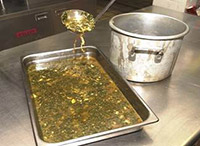Freeze or can soup and you will end up with a healthy food as you control the ingredients and the amount of added salt.
Freeze soup
Following the steps below to safely freeze soup.
- Use less liquid when preparing soup.
- Do not add potatoes because they become mushy after freezing - add them when you reheat soup before serving.
- Cool soup quickly by placing a soup-pot inside a larger container filled with ice. Stir often.
- Package soup in containers leaving 1-inch headspace after cooling. Or freeze in ice cube tray and store cubes in plastic bags.
- Label containers and place in freezer for up to 6 months.
Home canning soup
When home-canning soup, the canned soup must be processed in a pressure canner. Follow these safety precautions:
- For vegetable soup, fill the jars half full of solids, and add broth allowing 1 inch headspace. There needs to be space for the hot liquid to circulate between the food particles.
- Pieces of cooked beef or chicken can be added to the vegetables to make a vegetable meat soup.
- Use the process time for the ingredients that take the longest process time for the individual ingredients in the soup.
- Never can soup in half-gallon containers.
- Soups thickened with flour or cornstarch, creamed soups with dairy, or soups with pasta, rice or noodle, are NOT safe for home canning as their ingredients interfere with the proper transfer of heat during the processing step and can result in botulism illness.
- There are no scientifically research tested recipes for home-canning pumpkin, winter squash, broccoli, or cauliflower soup.
- Choose vegetables and prepare as you would for hot-pack canning.
- Rehydrate dried beans or peas before using them.
- Add cooked meat or poultry if desired.
- Cover ingredients with hot water, broth or tomatoes, and juice. Boil for 5 minutes.
- Add salt and other spices to taste.
- Do not add thickeners, flour, milk, cream, noodles, pasta, or rice. Add these ingredients when the soup is heated for serving.
- Fill canning jars halfway with solids from the soup mixture. Continue filling jars with hot liquid from the soup mixture, leaving 1" headspace.
- Process in a pressure canner.
- Use 11 pounds pressure for dial-gauge canner or 15 pounds pressure for weighted-gauge canner.
- Process pints for 60 minutes and quarts for 75 minutes.
- The University of Georgia. So Easy to Preserve. 2014. . Pp. 105, 310.
- National Center for Home Food Preservation. Soups.
Reviewed in 2021


